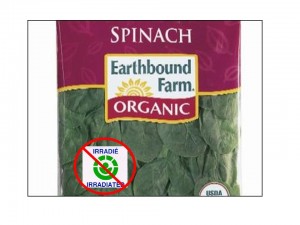Reynold Bergen, science director of the Beef Cattle Research Council, writes that irradiation has been used to pasteurize astronauts’ food since 1966.
Irradiation is also approved as a food safety treatment in over 50 countries back here on earth. For example, France, Belgium and the Netherlands use irradiation to combat foodborne pathogens in frogs’ legs, seafood, and poultry. The U.S. has approved irradiation of meat. Canada has approved irradiation for spices, seasonings, flour, onions and seed  potatoes, but not meat or poultry. Irradiation is safe for human food use at doses more than eight times higher than those approved for meat in the U.S. Irradiation does not cause the meat to become radioactive, and has less of an effect on food nutrients than cooking does, but irradiation can have undesirable effects on flavour or colour under some conditions.
potatoes, but not meat or poultry. Irradiation is safe for human food use at doses more than eight times higher than those approved for meat in the U.S. Irradiation does not cause the meat to become radioactive, and has less of an effect on food nutrients than cooking does, but irradiation can have undesirable effects on flavour or colour under some conditions.
Dr. Rick Holley at the University of Manitoba recently published two papers from research funded under Canada’s Beef Science Cluster.
One paper (Meat Science 96:413-418) examined whether a low dose (one kGy) of non-radioactive, ionizing electron-beam irradiation can eliminate verotoxigenic E. coli (VTEC) and salmonella from beef trim.
VTEC, also known as Shiga toxin-producing E. coli or STEC, are E. coli that can cause illness in humans. E. coli O157:H7 is one of about 200 serotypes of VTEC. More than a third of VTEC-related illnesses in humans are also caused by non-O157 serotypes such as the “top 6” E. coli O26, O45, O103, O113, O111, O121 and O145. Salmonella is relatively uncommon in beef, but is more irradiation resistant than E. coli because salmonella is better at repairing DNA damaged by irradiation.
The second paper (Journal of Food Science 78:920-925) examined whether e-beam irradiation of beef trim affects the colour, aroma, texture, juiciness or flavour of beef patties.
Over 30 different VTEC (including E. coli O157:H7 and the “top 6” non-O157 VTECs), and six different salmonella serovars were screened for resistance to the one-kGy e-beam. Twelve of these bacteria were then pooled in four groups to test for survivors on beef. Fresh muscle pieces (outside flat, inside round, brisket, and sirloin) were separately inoculated  with either 1,000 bacteria/gram or 10 million/g of each of the four bacterial mixtures. These numbers are up to a million times higher than would normally be found in beef. The inoculated beef was exposed to a one-kGy e-beam. Surviving bacteria were recovered and counted during storage at 4 C for up to five days. Inoculated muscle pieces were also pre-treated with five per cent lactic acid before being frozen and exposed to the e-beam.
with either 1,000 bacteria/gram or 10 million/g of each of the four bacterial mixtures. These numbers are up to a million times higher than would normally be found in beef. The inoculated beef was exposed to a one-kGy e-beam. Surviving bacteria were recovered and counted during storage at 4 C for up to five days. Inoculated muscle pieces were also pre-treated with five per cent lactic acid before being frozen and exposed to the e-beam.
For sensory tests, the same types of fresh muscle pieces (but not inoculated with bacteria) were treated with the one-kGy e-beam. Fresh ground beef patties (10, 20 or 30 per cent fat) were separately formulated with zero, 10, 20, 50 or 100 per cent lean beef treated with the one-kGy e-beam, cooked and evaluated by a similar panel for colour, aroma, texture, juiciness and flavour.
In spite of the artificially high level of experimental contamination, treating fresh beef with the one-kGy e-beam eliminated more than 99.99 per cent of the VTEC E. coli and 99 per cent of the salmonella. The e-beam had less effect on salmonella when used on frozen beef, but this could be overcome if the beef was dipped in five per cent lactic acid before freezing.
The trained panel observed no effects of irradiation on the colour, aroma, texture, juiciness or flavour of beef patties, even when they were made entirely with beef that had been e-beam treated.
Irradiation was highly effective even in beef that was experimentally contaminated with up to a million times more bacteria than would be found in retail beef. Under normal processing conditions, a one-kGy e-beam would be expected to eliminate the hazard represented by all types of VTEC E. coli. Low-dose (one-kGy) e-beam treatment can effectively control E. coli O157:H7, non-O157 VTEC E. coli and salmonella in fresh beef trim. The e-beam did not significantly affect any sensory attributes of the beef patties, regardless of how much irradiated beef they contained. Low-dose e-beam treatment of beef trim to formulate ground beef appears to be a viable pathogen mitigation process that does not affect product quality.





.jpg) (regardless of the standards applied by the farmer and butcher). Cooking an intact piece of meat on the surface is sufficient to kill any such bacteria. However, when a piece of meat is minced, contamination on the surface can be spread to any part of the product. … Irish mince is not irradiated, so the process of cooking through is crucial. E. coli infection can be fatal, so anyone who wishes to eat rare or raw minced beef in Ireland should take note of these facts.”
(regardless of the standards applied by the farmer and butcher). Cooking an intact piece of meat on the surface is sufficient to kill any such bacteria. However, when a piece of meat is minced, contamination on the surface can be spread to any part of the product. … Irish mince is not irradiated, so the process of cooking through is crucial. E. coli infection can be fatal, so anyone who wishes to eat rare or raw minced beef in Ireland should take note of these facts.” “Food irradiation of fresh produce is an additional tool that can help reduce the threat of foodborne illness — but it is not a magic bullet. The U.S. Food and Drug Administration has published a final rule allowing the irradiation of fresh iceberg lettuce and fresh spinach, available at:
“Food irradiation of fresh produce is an additional tool that can help reduce the threat of foodborne illness — but it is not a magic bullet. The U.S. Food and Drug Administration has published a final rule allowing the irradiation of fresh iceberg lettuce and fresh spinach, available at:  “He wasn’t alone in his misery. He was among a small group of people who contracted salmonella when a restaurant cook failed to properly clean a cutting board where raw chicken had been cut. …
“He wasn’t alone in his misery. He was among a small group of people who contracted salmonella when a restaurant cook failed to properly clean a cutting board where raw chicken had been cut. … The steady pace of food-safety scares — and growing consumer awareness of food-safety risks — will improve consumer acceptance of irradiated greens, says Doug Powell of the I
The steady pace of food-safety scares — and growing consumer awareness of food-safety risks — will improve consumer acceptance of irradiated greens, says Doug Powell of the I